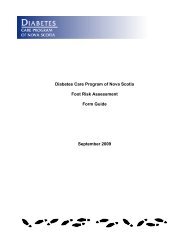CDE Appendix 1 Literature Review - Central East Local Health ...
CDE Appendix 1 Literature Review - Central East Local Health ...
CDE Appendix 1 Literature Review - Central East Local Health ...
You also want an ePaper? Increase the reach of your titles
YUMPU automatically turns print PDFs into web optimized ePapers that Google loves.
The Culture, Diversity and Equity Project: <strong>Literature</strong> <strong>Review</strong><br />
• Epidemiology of specific health and health-care disparities;<br />
• Factors underlying health and health-care disparities—access, socioeconomic, environment, institutional,<br />
racial/ethnic;<br />
• Demographic patterns of health-care disparities, both local and national; and<br />
• Collaborating with communities to eliminate disparities—through community experiences.<br />
• Domain V: Cross-Cultural Clinical Skills<br />
• Knowledge, respect, and validation of differing values, cultures, and beliefs, including sexual orientation,<br />
gender, age, race, ethnicity, and class;<br />
• Dealing with hostility/discomfort as a result of cultural discord;<br />
• Eliciting a culturally valid social and medical history;<br />
• Communication, interaction, and interviewing skills;<br />
• Understanding language barriers and working with interpreters;<br />
• Negotiating and problem-solving skills; and<br />
• Diagnosis, management, and patient-adherence skills leading to patient compliance (AAMC, 2005, p. 9).<br />
2. Specific Components Grid<br />
The second part (Specific Components) of the TACTT identifies and details the specific knowledge (K), skills (S),<br />
and attitudes (A) that need to be taught and evaluated for, under each of these five domains.<br />
5.3. LIMITATIONS OF THE TRAINING LITERATURE, FRAMEWORKS & STANDARDS<br />
(1) Lack of evidence-base and quality evaluation<br />
One of the greatest limitations of the existing cultural competence training literature is the lack of empirical data<br />
concerning what makes diversity training, and linguistically and culturally appropriate health education training in<br />
particular, effective (Curtis et al., 2007; Anderson et al., 2003).<br />
Much of this has to do with the poor methodological design and/or rigour of the few evaluations in the literature that<br />
do examine the impact of cultural competence training on minority health care quality (Beach et al., 2005; Beach et<br />
al, 2006; and Curtis et al., 2007). Most such studies, for instance, rely on self-administered tools for evaluation that<br />
have not been validated (Gozu et al., 2007) 35 and base themselves on post-test only or single group pre-test/post-test<br />
self-reports of knowledge and attitudes acquired in the process (Haarmans, 2004).<br />
While there is some evidence that properly designed cultural competence training can change trainees attitudes<br />
(Curtis et al., 2007; Crosson et al., 2004; ), there is a lack of evidence substantiating that such training improves<br />
‘patient adherence to therapy, health outcomes, and equity of services across racial and ethnic groups’ (Beach et al.,<br />
2005).<br />
(2) Attitude focus<br />
A second major limitation of cultural competence training discussed in the literature concerns the continuing overemphasis<br />
in a lot of cultural competence training designs on awareness-building aimed at attitude change. “The<br />
literature indicates that current diversity training practices begin and end with awareness building” Curtis et al., for<br />
instance conclude, in their (2007) review of diversity and cultural competence training literature between 2000 and<br />
2005.<br />
35 Curtis et al., (2007) for instance note, in the former respect, a significant discrepancy between the reported results of subjective (self-report)<br />
measures of attitude change, and the results of survey methods measuring attitude change using standardized instruments, which are much more<br />
mixed.<br />
104

















